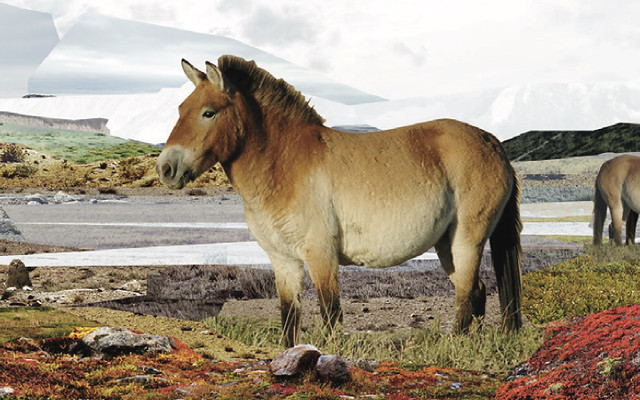Equus lambei (common names include Yukon horse, and Yukon wild horse[1][7]) is an extinct species of the genus Equus. Equus lambeiranged across North America until approximately 10,000 years ago. Based on recent examinations of the mtDNA of Equus lambei remains, scientists have concluded that E. lambei was probably was much like the extinct Tarpan, also known as the Eurasian wild horse, and the living Przewalski’s Horse.[6][8] A partial carcass of Equus lambei is on display at the Yukon Beringia Interpretive Centre in Whitehorse, Yukon[1].
Evidence from E. lambei mtDNA has shown that Equus lambei is close relative of the modern wild horse, including the domestic horse, Equus caballus[2][3][4][7]. Controversy still surrounds E. lambei and the divergence of other similar extinct horse species. Through examinations of the bones and teeth of Equus lambei, many similarities can be seen with the modern horse Equus caballus. There is also a strong resemblance to E. lambei in the metapodials of E. caballus przewalskiiand the phalanges of E. caballus lenensis [7].
Metrical and morphological studies of horse teeth from the Bluefish Caves confirm the close similarity between Equus lambei with wild and domestic horses alive today[6]. E. lambei is a caballus horse, not an ass[7]. The closest resemblance to E. lambei is shown by the Mongolian horse, E. caballus przewalskii, now believed to be extinct in the wild. In size and proportions, E. lambei resembles E. caballus przewalskii. Among living horses, perhaps the Yukon horse most closely resembles the Przewalski’s horse (Equus caballus przewalskii) from Mongolia [7]. The upper foot bones (metapodials) of Equus lambei are slender compared to Przewalski’s horse[7]. The bones of E. lambei also closely resemble the proximal phalanges of E. caballus lenensis, an extinct species from the late Pleistocene of Siberia [8].
(From Wikipedia, June 2018)




